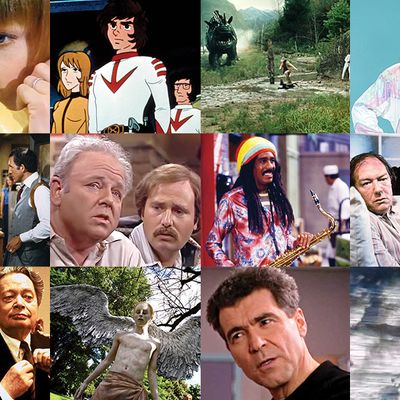Who needs new TV shows? In this week’s issue of the magazine, our critics show us what’s in their personal collections of old culture, much of it you might’ve missed. All of it is available online, somewhere. Herewith, Matt Zoller Seitz on the eight great TV series you probably haven’t seen and seven great single episodes (or TV movies) you can find online.
SERIES
1. The Comeback (2005)
This HBO faux-reality program from Sex and the City showrunner Michael Patrick King follows washed-up sitcom actress Valerie Cherish (Lisa Kudrow) as she struggles to reignite her career. It’s one of the greatest one-season wonders in TV history, as corrosively funny and honest as early Albert Brooks: It’s hide-under-the-couch humor.
2. The Richard Pryor Show (1977)
You know Pryor as the foulmouthed storytelling genius of standup comedy and the mostly watered-down clown of scripted features, but you might not have experienced another facet of his talent: as a variety-show impresario who tackled race and class with a frankness never seen before (or, arguably, since).
3. The Kingdom (1994)
Of all the horror series influenced by Twin Peaks, this Danish hospital soap from Lars von Trier (Antichrist, Dogville) might be the greatest; it’s periodically made available via legal streaming services, but the DVD is out of print and only a few copies are available, so it’s worth going the extra mile to seek it out. Just don’t watch it by yourself.
4. Star Blazers (1979–1981)
The vogue for dubbed Japanese cartoons began in the seventies with Battle of the Planets, but this epic series about a refurbished battleship setting sail across the galaxy to save an apocalypse-ravaged Earth remains the reigning masterpiece of that era—and its serialized storytelling was ahead of its time.
5. The Newsroom (1996–2005)
The CBC’s great comedy about the intellectual and ethical compromises at a daily-news show has the same name as HBO’s Aaron Sorkin lecture-fest, but it’s a hundred times smarter and much subtler. It’s great—Larry Sanders Show great, as a matter of fact.
6. The Singing Detective (1986)
Dennis Potter’s musical psychodrama is about a detective (Michael Gambon) who memory-trips while bedridden by a horrendous skin disease; watch even an hour of it, and you’ll instantly sense that it’s one of the most profound creative influences on post-Sopranos TV and that Tony’s sixth-season sojourn in dream-space owes it quite a debt.
7 and 8. Clone Wars (2003–2005) and Samurai Jack (2001–2004)
The world’s greatest living action filmmaker isn’t Michael Bay, James Cameron, or Steven Spielberg: It’s animator and illustrator Genndy Tartakovsky, who absolutely killed it with his cel-style Samurai Jack (a postapocalyptic sci-fi fantasy) and Clone Wars in the aughts. Every sequence is a marvel of bold, simple graphics, whip-crack timing, and strategic use of silence and overwhelming noise.
1. The Lathe of Heaven (1980)
PBS aired this adaptation of Ursula K. Le Guin’s novel about a man whose dreams come true, and its reputation has deservedly deepened with time. A touchingly young Bruce Davison plays the dreamer, George Orr; the film’s “futuristic” landscapes are mostly just newish buildings, and the score is all analog synthesizers except for the cover of “With a Little Help From My Friends,” used in a sequence involving a humanoid tortoise with a lightbulb for a face. Singular and striking.
2. The Last Dinosaur (1977)
This Japanese and American co-production about a big-game hunter (a pretty clearly soused Richard Boone) tracking a T-Rex at the center of the Earth sounds silly, but if you can appreciate the old-school miniature landscapes and Godzilla-style creature costumes (and you should, because they’re amazing), the net effect is strangely haunting.
3. Masters of Horror “Homecoming” (2005) and “Cigarette Burns” (2005)
This Showtime horror anthology from Stephen King buddy Mick Garris was hit-and-miss, but these two episodes—a post-9/11 antiwar nightmare by Joe Dante, and a cinephile’s fantasy-slash-nightmare of the ultimate find, by John Carpenter—are classics ranking with the best of The Twilight Zone and The Outer Limits.
4. All in the Family “Two’s a Crowd” (1978) and “Edith’s 50th Birthday Parts 1 & 2” (1977)
Incredible as it might seem now, this socially aware Norman Lear sitcom isn’t the constant pop-culture presence it once was; if you’ve never sampled it, start with these three classic episodes. The first reveals the roots of Archie Bunker’s bigotry and anger. The others put Archie’s wife, Edith, in a situation that’s as grimly funny as it is horrifyingly tense, then deals (touchingly) with the aftermath.
5. Frank’s Place “Pilot” (1987)
Unless you were one of the maybe eight people who watched this great comedy during its brief 1987–88 run on CBS, you have no idea why it keeps getting mentioned on lists of the great one-season shows of all time. Plug that knowledge gap forthwith by watching the pilot, which still feels uncategorizably fresh 26 years later.
6. Hill Street Blues “Trial by Fury” (1982)
Ask anybody of a certain age, inside the TV industry or out, when they first realized that television could be art, and there’s a good chance they’ll mention this episode scripted by a young David Milch (Deadwood), in which precinct captain Furillo goes beyond the law to bring “justice” to
a couple of rapists and suffers a real moral price.
7. Mary Hartman, Mary Hartman “Pilot” (1976)
Produced by All in the Family’s Norman Lear and directed by Joan Darling and Jim Drake, this star vehicle for comic actress Louise Lasser was one of the boldest series of the seventies: a laugh-track-free send-up of soap operas that was also a surprisingly probing and intense critique of capitalism. Yes, really!
*This article originally appeared in the November 18, 2013 issue of New York Magazine.
Eight Great TV Series You Probably Haven’t Seen



